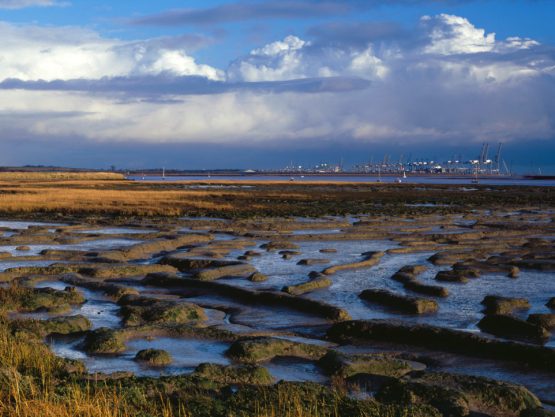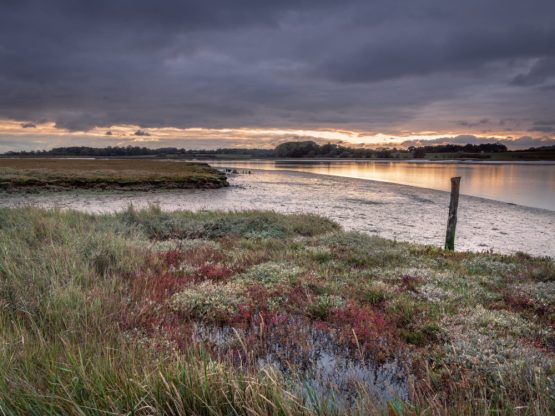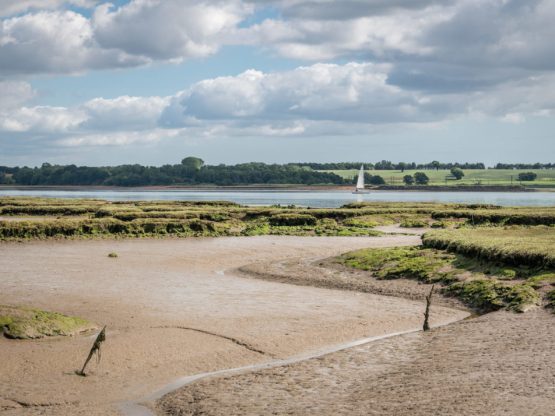Saltmarsh

The tidal estuaries found in the Suffolk & Essex Coast & Heaths National Landscape are some of the most special places anywhere in the country, rich with wildlife and character. The Stour, the Orwell, the Deben and the Alde and Ore each have their own history and significance and are internationally important habitat for birds.
One vital aspect of the estuaries is saltmarsh. This special feature of the landscape can be often overlooked but is essential for the functioning ecosystem.
Over several decades, artist and academic, Simon Read, has gained valuable insight into how estuaries and coastal dynamics work and he explains more about saltmarsh and its role in the Suffolk & Essex Coast & Heaths National Landscape.
What is a saltmarsh? Although also known as the meadows of the sea, don’t be deceived, saltmarsh is a highly specialised and delicate ecosystem nourished twice daily by the tide. It can only occupy the intertidal zone of our coast and estuaries and owes its identity to both the marine and terrestrial environment.
Before the extensive engineering works of the 17th to the 20th centuries reclaimed coastal floodplains for agriculture, all coastal and estuarine territory below mean high water was subject to regular tidal inundation; it was a shifting and inconstant landscape supplied with fine sediments from coastal erosion and drainage from the land, to be deposited on the shallow foreshore by the tide as its vigour slowed down.
Utterly at the mercy of prevailing weather systems and sculpted by wave and tidal action, saltmarsh is in perpetual transition and performs a vital role in the dynamic of an estuary and its systems.
Saltmarsh occupies a niche between low-water neaps and high-water springs and is host to its own highly specialised communities of flora and fauna. Saltmarsh plants are essentially variants of their terrestrial cousins that have adapted to a salt environment and can be classified according to their degree of tolerance to saltwater inundation.
Apart from seagrasses that occupy foreshore sites and are highly vulnerable to fluctuation in water quality, the lowest levels are occupied by plants such as samphire, that are highly salt tolerant and act as pioneers in the propagation of saltmarsh through their capability to interrupt tidal flow and trap sediment.
Cordgrass or spartina, colonises mudflats and can proliferate rapidly, forming a monoculture that outcompetes other varieties of saltmarsh plant. Spartina anglica, a hybrid that has developed in UK, is considered a particularly problematic invasive species, where it hasn’t been exploited in reclamation projects for its capacity to trap sediment and rapidly propagate.
These pioneers are the first stage in a succession of plants for which their salt tolerance varies according to frequency and duration of tidal immersion. As sediment accumulates and vegetable matter dies and rots down the marsh gradually becomes elevated beyond the reach of every tide until it reaches a level only covered on exceptionally high tides and transitional to a normal terrestrial environment.
Between the pioneer stage and the high marsh grasses there is a huge range of saltmarsh plants each highly specialised and each occupying its own niche. These include sea purslane that thrives on the well-drained edges of the drain channels and stands of sea lavender, which are always a sign of a healthy marsh.
A heathy saltmarsh is characteristically an area raised to the level of high-water springs and dissected by an intricate system of drain channels. When the tide enters a marsh, its flow slackens in the fine filigree of channels that reach into its interior, until at high water when it slackens, and drops, leaving behind its load of sediment and organic material. From above, any saltmarsh has a complete and integrated form, it is dendritic, tree-like. So long as it is free from interference this is a self-perpetuating system with its own biodiversity.
The daily tidal exchange ensures a rich invertebrate community that attracts wading birds such as curlew, godwit, redshank, and oystercatcher and with any luck avocet and spoonbill, which, when the tide is full, retreat to the high marsh to roost and frequently to nest. And with the rising of the tide juvenile fish, dab, flounder, bass, and mullet enter the channels to feed, which in turn attract the predatory egret, heron and cormorant, over all of which presides the ever-vigilant marsh harrier.
To be out on the marsh is to enter a world of fragile beauty but enter with care, it is not dry land, it is fugitive and easily disturbed, but given respect, you might just experience something extraordinary and magical.


